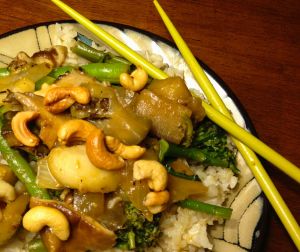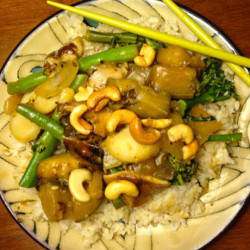Tuesday, February 19, 2013
There was a time many, many years ago before I learned to cook global cuisine when I thought a “Chinese stir fry” involved simply adding soy sauce to some sautéed vegetables.
Ah, what little I knew.
It was the Frog Commissary Cookbook that taught me better, and I’ve been been making variations of this fabulous recipe ever since. Using veggie rather than chicken stock and employing low-sodium soy sauce (Bragg’s amino acids can be used if you prefer) also make my sauce heart- and planet-healthier without any compromise whatsoever on flavor.
My stir fry mix generally includes some tantalizing combination of veggies that inspire, toasted nuts, water chestnuts or bean sprouts, and occasionally a protein like tofu. Serve over brown rice or toss with whole grain udon or soba noodles (or spaghetti) and you’ve got an authentic-tasting, mouth-watering meal packed with fiber, vitamins, minerals and phytonutrients.
Make no mistake, though, as much as I love creating different mixtures that suit my mood and season, this recipe is all about the sauce, which will fill your house with the pungent fragrancy of your favorite Chinese take-out and make your taste buds rejoice in wonderment.
And I don’t care how ridiculous you think that sounds, because it’s true.
* * * * *
Ingredients
- 2 tbsp sesame oil
- 2 tbsp garlic, crushed
- 1-2 tbsp fresh ginger, grated or minced
- 1-1 1/2 cup vegetable stock, low- or no-sodium, preferably homemade
- 1/3 cup sesame oil
- 2 tbsp low-sodium soy sauce or Bragg’s amino acids
- 1-2 tbsp brown sugar
- Juice from 1/2 lemon or lime
- 1/2 tsp black pepper, freshly ground
- 1/4 tsp cayenne
- 1 tsp sriracha or tabasco
- 2-3 tsp corn starch
- 2 tbsp rice wine or vinegar
Instructions
 In a saucepan, sauté the garlic and ginger in the sesame oil over medium-high heat for 30-45 seconds, until fragrant. Pour in veggie stock and sesame oil. Season with soy sauce, brown sugar, and citrus, adding pepper(s) and sriracha or tabasco as desired. Stir and bring to a boil. Dissolve corn starch in rice wine or rice vinegar and whisk into the sauce, boiling until thickened. If the mixture is too thin, add additional corn starch/wine.
In a saucepan, sauté the garlic and ginger in the sesame oil over medium-high heat for 30-45 seconds, until fragrant. Pour in veggie stock and sesame oil. Season with soy sauce, brown sugar, and citrus, adding pepper(s) and sriracha or tabasco as desired. Stir and bring to a boil. Dissolve corn starch in rice wine or rice vinegar and whisk into the sauce, boiling until thickened. If the mixture is too thin, add additional corn starch/wine.
Cooking Notes
The quantities of the ingredients are shown for magnitude and aren’t exact: you need a goodly amount of the liquids like stock and sesame oil, but the seasonings are very much to taste. Like it sweeter? Use the higher amount of sugar, or more. Like it spicier? Include more sriracha and use less sugar. Enjoy more tang? Use a bit more lemon juice or rice wine/vinegar. This recipe rarely requires salt given soy sauce is salty (even the low-sodium variety), so I don’t recommend adding salt unless you really need it at the end.
And have fun! As long as you remember to always begin with the lesser amount and taste as you proceed, the seasonings can easily be adjusted to suit your palate, as can the viscosity of the sauce.
Happy Belated Chinese New Year!





